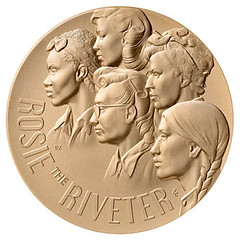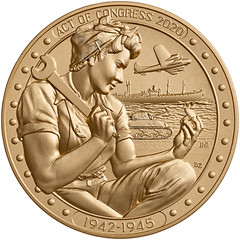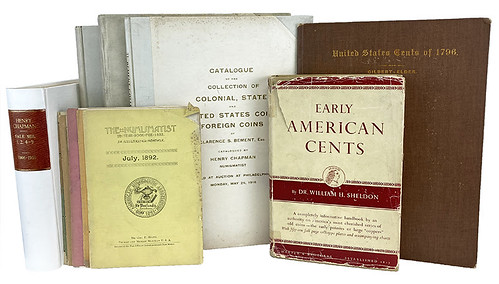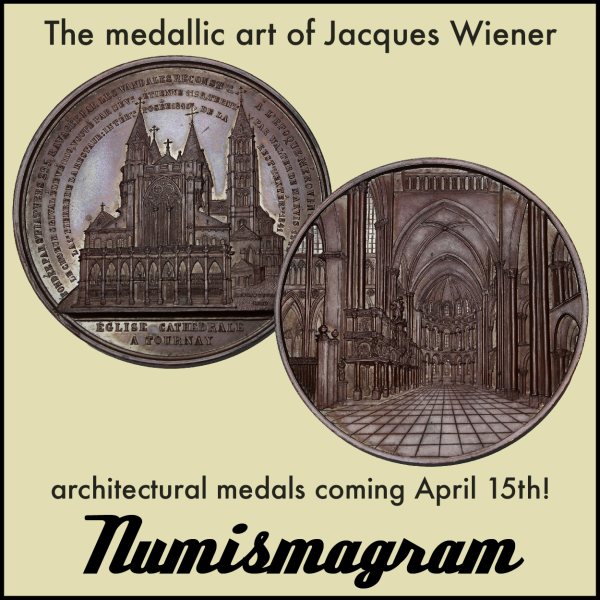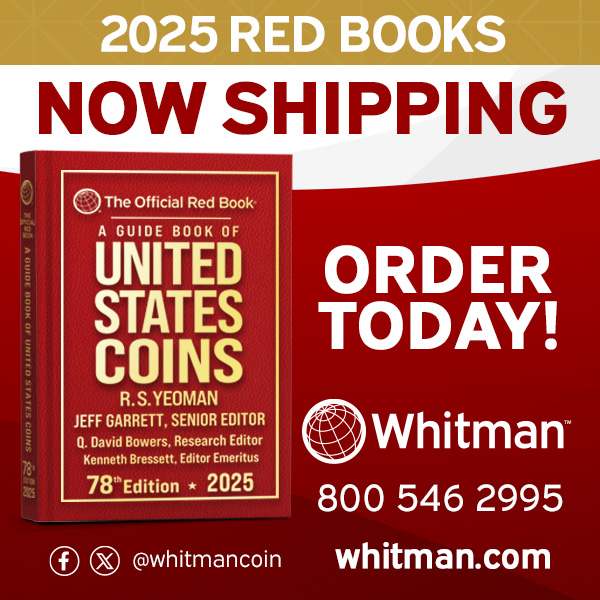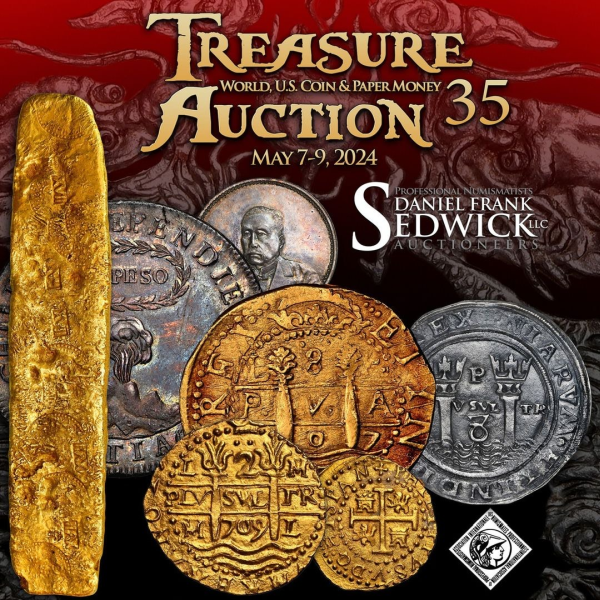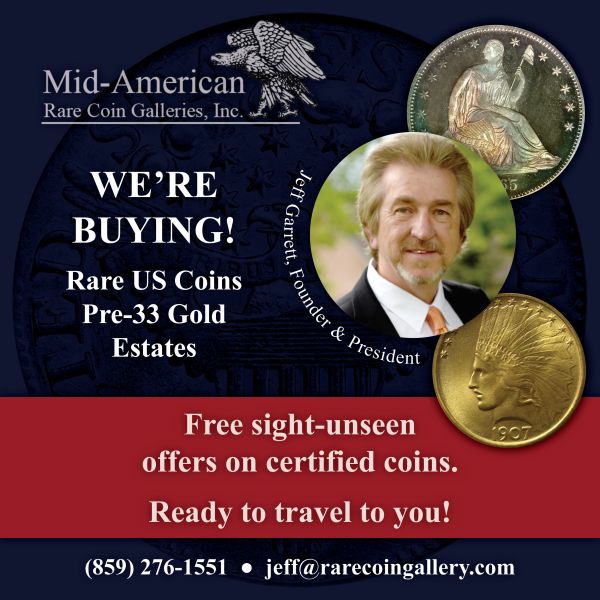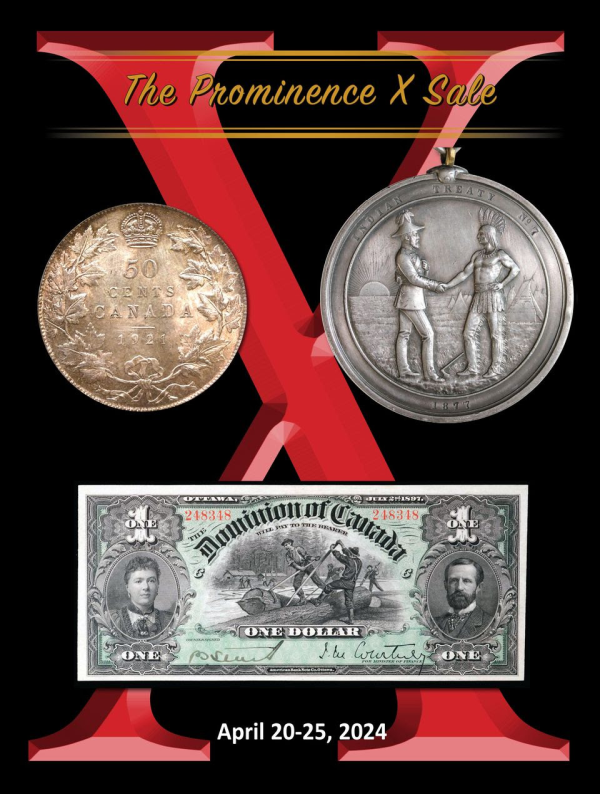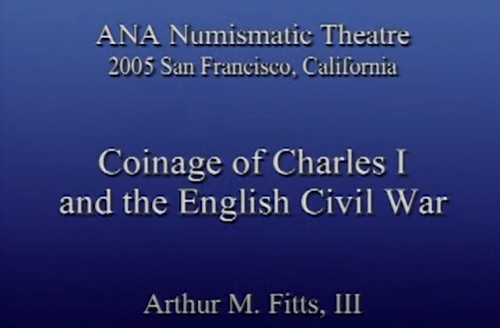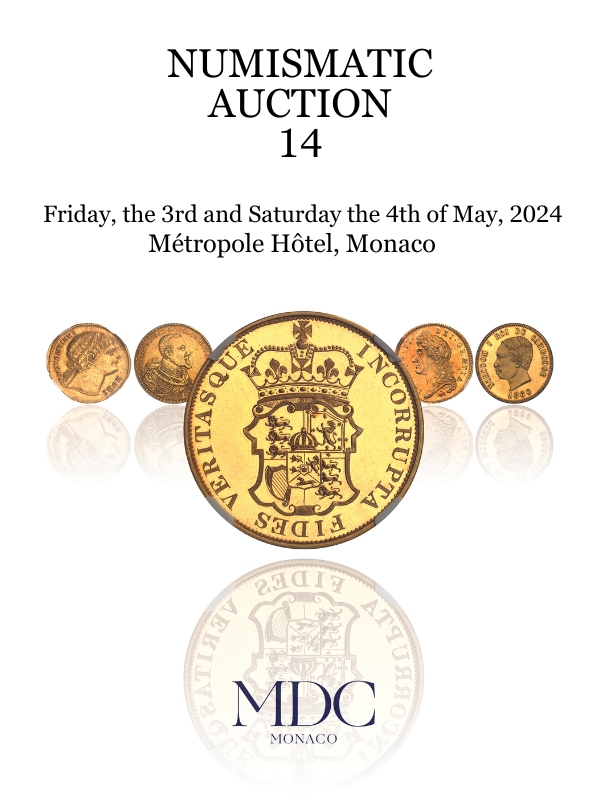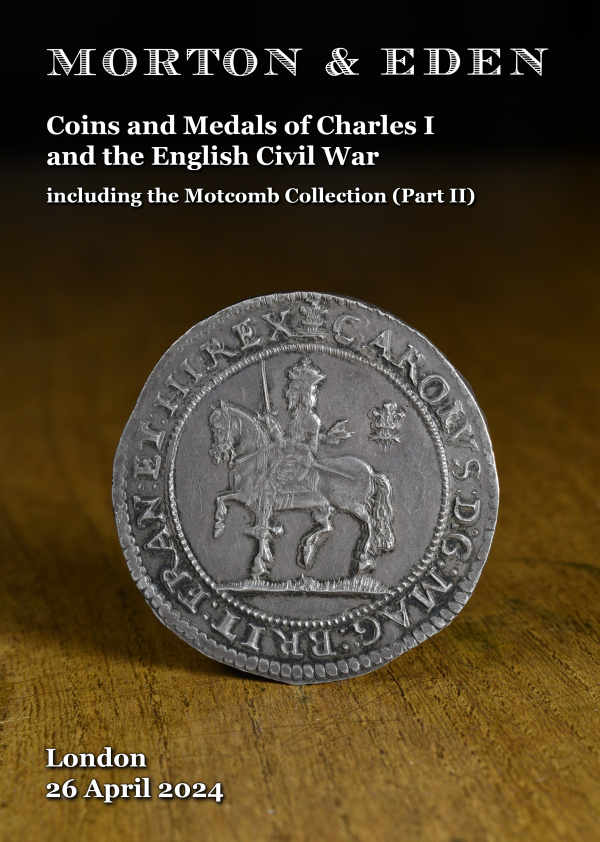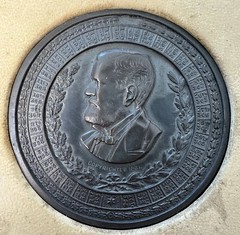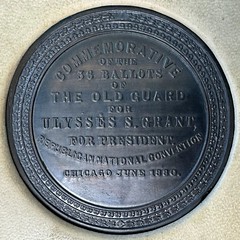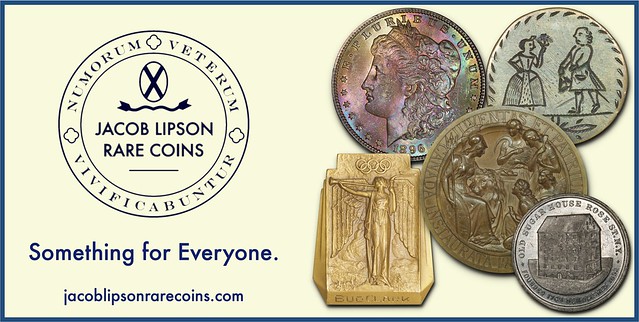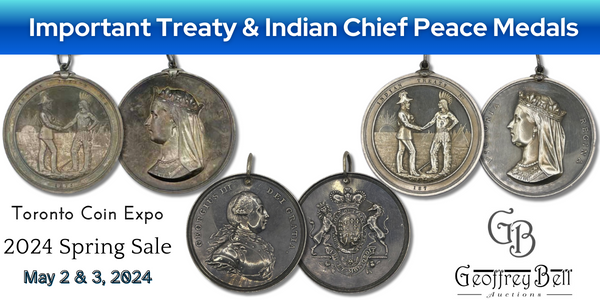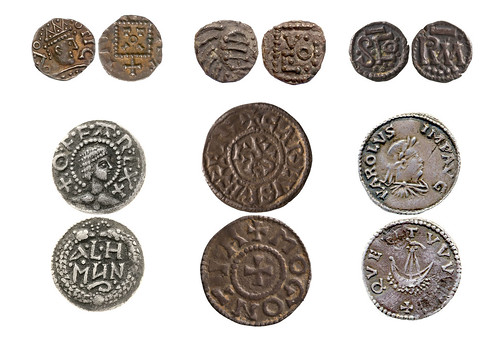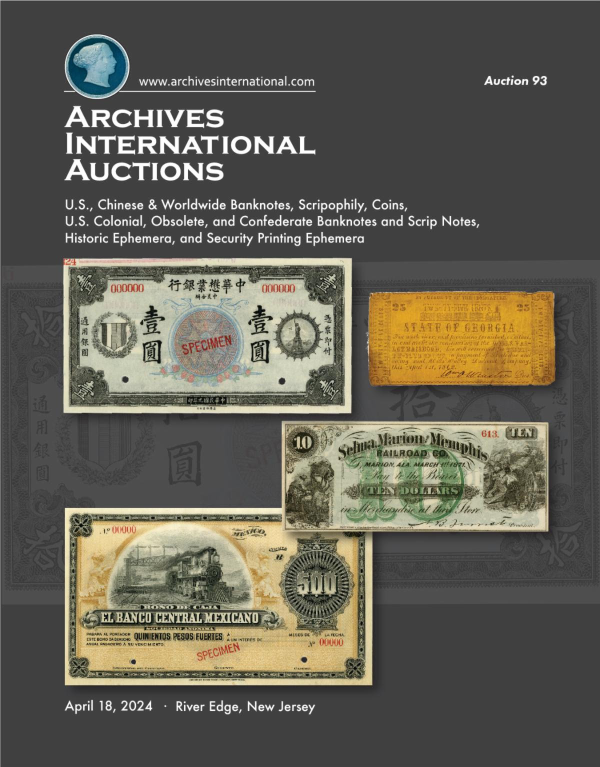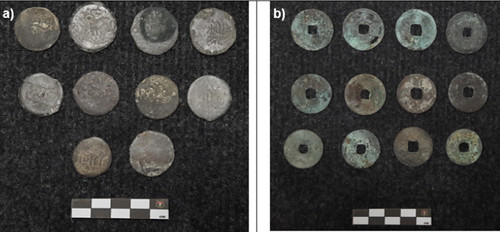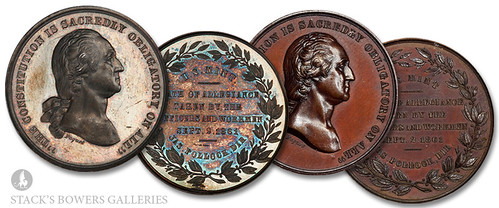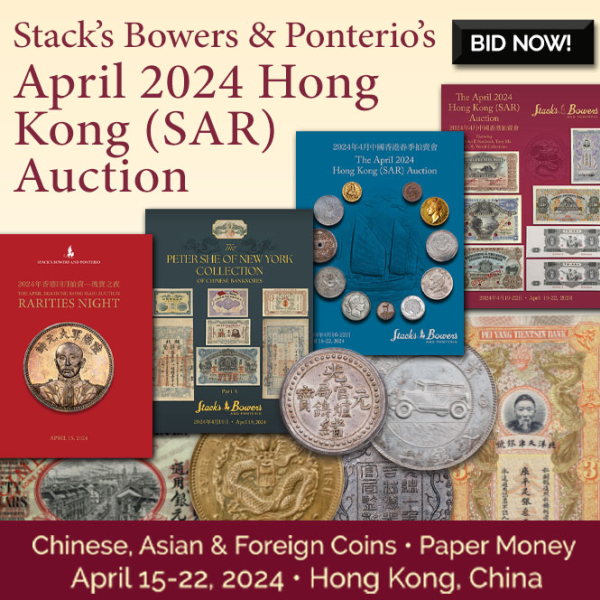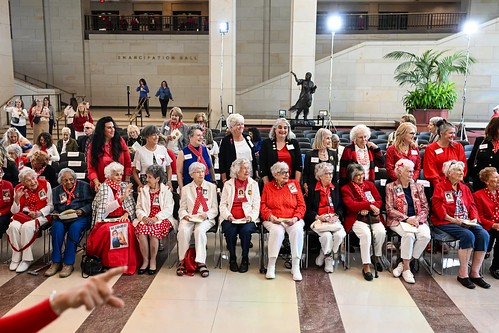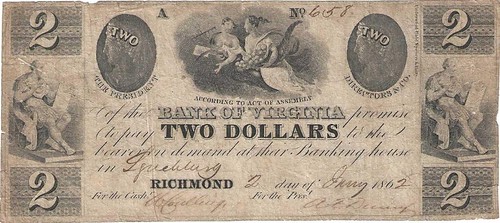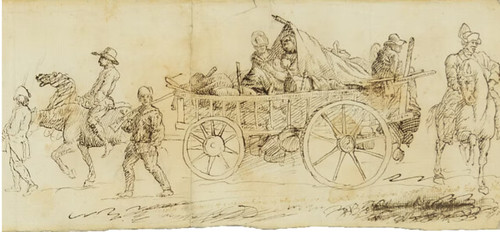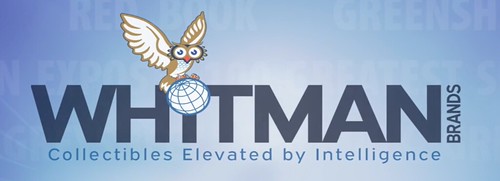
Visit our NBS Sponsors




About UsThe Numismatic Bibliomania Society is a non-profit association devoted to the study and enjoyment of numismatic literature. For more information please see our web site at coinbooks.org SubscriptionsThose wishing to become new E-Sylum subscribers (or wishing to Unsubscribe) can go to the following web page link MembershipThere is a membership application available on the web site Membership Application To join, print the application and return it with your check to the address printed on the application. Print/Digital membership is $40 to addresses in the U.S., and $60 elsewhere. A digital-only membership is available for $25. For those without web access, write to: Jeff Dickerson, Treasurer AsylumFor Asylum mailing address changes and other membership questions, contact Jeff at this email address: treasurer@coinbooks.org SubmissionsTo submit items for publication in The E-Sylum, write to the Editor at this address: whomren@gmail.com BUY THE BOOK BEFORE THE COINSale CalendarWatch here for updates! |
- WAYNE'S WORDS: THE E-SYLUM APRIL 14, 2024
- NBS 2024 CHARITY AUCTION DONATIONS SOUGHT
- NEW BOOK: TETRARCHIC HOARDS FROM ROMAN BRITAIN
- NEW BOOK: CHARLTON CANADIAN COINS 77TH ED.
- NEW BOOK: NUMISMATIC DOCUMENTS OF THE HISPANIC CARIBBEAN
- NEW BOOK: PLASTIC TRANSPORTATION TOKENS OF CHINA
- MAX JACOB HUMBERT (1929-2024)
- RALPH JAMES WINTER (1944-2024)
- EDWARD LEE CRAIG (1946-2024)
- JOHN EDWARD GUSMANO (1963-2024)
- NNP ADDS TO CONGRESSIONAL REPORT SERIES
- VIDEO: COINAGE OF THE ENGLISH CIVIL WAR
- NOTES FROM E-SYLUM READERS: APRIL 14, 2024
- VOCABULARY TERM: PIERCING
- COPE COLLECTION OF BRITISH COINS OFFERED
- GRANT REUNION BOOK AND MEDAL
- THURSDAY LUNCH CLUB REPORT APRIL, 2024
- COINS OF JUSTINIAN THE GREAT
- ON COLLECTING BYZANTINE COINS
- BYZANTINE SILVER BECAME MEDIEVAL COINS
- MALAYSIAN SHIPWRECK COIN FIND
- CANADA’S FIRST AMERICAN VICTORIA CROSS
- U.S. MINT OATH OF ALLEGIANCE MEDALS
- ROSIE THE RIVETERS CONGRESSIONAL GOLD MEDAL
- PAPER MONEY OF FREDERICKSBURG, VA
- LOOSE CHANGE: APRIL 14, 2024
- DU SIMITIERE SKETCH DISCOVERED
- FEATURED WEBSITE: WHITMAN BRANDS
Content presented in The E-Sylum is not necessarily researched or independently fact-checked, and views expressed do not necessarily represent those of the Numismatic Bibliomania Society.
WAYNE'S WORDS: THE E-SYLUM APRIL 14, 2024
 New subscribers this week include:
Robert Warren.
Welcome aboard! We now have 7,291 subscribers.
New subscribers this week include:
Robert Warren.
Welcome aboard! We now have 7,291 subscribers.
Thank you for reading The E-Sylum. If you enjoy it, please send me the email addresses of friends you think may enjoy it as well and I'll send them a subscription. Contact me at whomren@gmail.com anytime regarding your subscription, or questions, comments or suggestions about our content.
We had no new books to report last week, an unusual occurrence lately. But not this time. This week we open with FOUR new books (that's great!), FOUR obituaries (that's not so good), updates from the Newman Numismatic Portal, and more.
Other topics this week include Canadian coins, the numismatic of Puerto Rico, Cuba, and the Spanish Caribbean, Chinese transportation tokens, Paramount International Coin Corporation, making dies for elongated coins, the English Civil War, the 1893 Grant Reunion, Justinian the Great, coin finds, and U.S. Mint Oath of Allegiance medals.
To learn more about the London Mint of Constantius and Constantine, Max Humbert, Congressional Reports with numismatic content, starting Teletrade, a numismatic earworm, the Cope Collection, the American who earned a Canadian Victoria Cross, the Rosie the Riveter Congressional Gold Medal, and Nigerian banknote abuse, read on. Have a great week, everyone!
Wayne Homren
Editor, The E-Sylum
NBS 2024 CHARITY AUCTION DONATIONS SOUGHT
Each year at the ANA World's Fair of Money, the Numismatic Bibliomania Society conducts a charity auction to raise funds for the organization. NBS President Len Augsburger submitted this announcement of this year's auction. Here's a repeat of last week's announcement with this important addition - potential donors must contact Len and auctioneer David Fanning by email before shipping. They may be reached at leonard_augsburger@hotmail.com and DF@numislit.com respectively. They'll need to monitor the volume and mix of material to ensure a successful auction. Thank you. -Editor
NBS Solicits Donations for 2024 Charity Auction
The NBS requests donations of numismatic literature for the 2024 Charity Auction, which will be held at the ANA convention in August. The Charity Auction covers a good portion of the NBS annual expenses, and we gratefully acknowledge past donors and bidders. While material at varied price points is welcome, we especially encourage donations of literature valued at $100 and up. Top honors from last year’s sale went to Carl Würtzbach’s annotated and plated copy of Henry Chapman’s Bement sale (1916), donated by David Steine, which realized $3,000. Donations may be sent to NBS president Len Augsburger at 16 N. Fiore Parkway, Vernon Hills, IL 60061.
NEW BOOK: TETRARCHIC HOARDS FROM ROMAN BRITAIN
Hugh Cloke of Georgetown University writes:
"The first of three important books on Roman coinage in Britain from the late third and early fourth centuries was published by the British Museum on March 24. The book is available to order in hard copy from the Museum, which has also published an open access, low resolution pdf edition of the book.
"Lee Toone and I are expecting that any day now we'll receive a set of revised pages for the new edition of our book, The London Mint of Constantius and Constantine, which we hope Spink will issue in May or June.
"The third book, Sam Moorhead's volume on the coinage of Carausius and Allectus, will be issued later this year as a part of the series Roman Imperial Coinage. Sam contributed a Forward to our upcoming book."
Thanks. Here's information on the first book. -Editor
NEW BOOK: CHARLTON CANADIAN COINS 77TH ED.
The new 2024 Charlton Canadian Coins book is available. -Editor
2024-25 Charlton V1 Canadian Coins — 77th Edition
$36.95
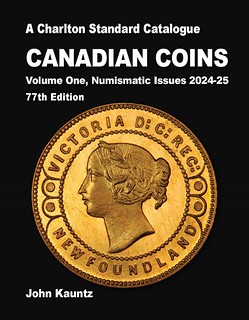 The 77th edition of the Charlton Vol 1 catalogue, unveiled on April 9, 2024, meticulously showcases, catalogs, and values the complete spectrum of Canadian coins spanning from the 1600s to the contemporary era. In addition to comprehensive coverage of circulating coinage, the catalogue features entries on foreign coins circulated in Canada during the 17th to 19th centuries, local pre-decimal coins, as well as coins originating from Nova Scotia, New Brunswick, Prince Edward Island, Newfoundland, and the Province and Dominion of Canada.
The 77th edition of the Charlton Vol 1 catalogue, unveiled on April 9, 2024, meticulously showcases, catalogs, and values the complete spectrum of Canadian coins spanning from the 1600s to the contemporary era. In addition to comprehensive coverage of circulating coinage, the catalogue features entries on foreign coins circulated in Canada during the 17th to 19th centuries, local pre-decimal coins, as well as coins originating from Nova Scotia, New Brunswick, Prince Edward Island, Newfoundland, and the Province and Dominion of Canada.
Furthermore, it encompasses sections dedicated to specimen coins, trial pieces, official fabrications, and test tokens. This year’s edition of the catalogue also boasts Part 2 of the Canadian Coin Variety Catalogue (first edition) authored by Hans Zoell.
NEW BOOK: NUMISMATIC DOCUMENTS OF THE HISPANIC CARIBBEAN
Ángel Navarro Zayas has published a new book in Spanish compiling important numismatic documents relating to Puerto Rico, Cuba, and the Spanish Caribbean. Congratulations! It's available in print-on-demand on Lulu.com. Below is a Google-translated description. -Editor
Documentos Numismáticos del Caribe Hispano (Siglo XIX)
Numismatic Documents of the Hispanic Caribbean (19th Century)
By Ángel Navarro Zayas
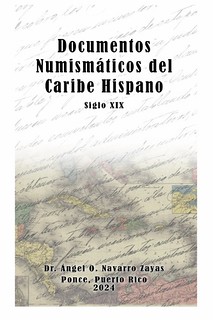 Numismatics is a branch of history that analyzes coins, paper money (notafilia), exonumia and medals, among other subspecialties. Marks of rulers, civilizations, and historical events are frequently seen on coins and banknotes, making them a valuable tool of historical information. It is recognized that one of the sovereign symbols of a country or nation is the minting of coins for general circulation.
Numismatics is a branch of history that analyzes coins, paper money (notafilia), exonumia and medals, among other subspecialties. Marks of rulers, civilizations, and historical events are frequently seen on coins and banknotes, making them a valuable tool of historical information. It is recognized that one of the sovereign symbols of a country or nation is the minting of coins for general circulation.
The research and study of coins allows for a better understanding of the economic, political and cultural history of a civilization. Coins and medals serve to preserve the rich cultural legacy of a nation or group of nations. This is what happens with the documents we present here. Our object of study for this research has been to recover from the National Historical Archive in Madrid, primary documents that deal with the Hispanic region of the Caribbean in the 19th century, including Cuba, Hispaniola and Puerto Rico.
NEW BOOK: PLASTIC TRANSPORTATION TOKENS OF CHINA
Jim Contursi has published a new book on the plastic transportation tokens of China. Congratulations! -Editor
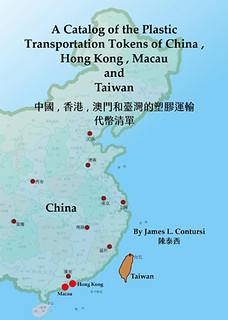 A Catalog of the Plastic Transportation Tokens of China, Hong Kong, Macau and Taiwan, up to and including 2023, is hot off the press.
A Catalog of the Plastic Transportation Tokens of China, Hong Kong, Macau and Taiwan, up to and including 2023, is hot off the press.
This is the first time such a detailed undertaking of these tokens has been published, and it covers all modes of transportation: bus, ferry, metro and rail.
This work lists more than 230 pattern/prototype, test, regular-issue, commemorative, souvenir, advertising, and travel-pass tokens.
The introduction is in English, but all token legends in Chinese are translated into English and supplemented with pinyin transliteration.
MAX JACOB HUMBERT (1929-2024)
Tom Mulvaney notified me of the passing of Max Humbert, one of the founders of Paramount International Coin Corporation. Thanks. Born January 25, 1929, in North Canton, Ohio, he passed at the age of 95 February 29, 2024 in Rockwood, Tennessee.
Here's an introduction from Tom followed by an article about Max from The Paramount Journal (Volume 1, No. 2, June 1973), and more. -Editor
Tom writes:
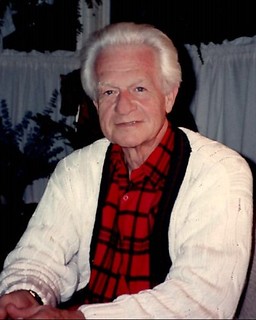 "Before getting into the coin business, Max was a freight agent with the B&O Railroad in Dayton, OH. He was one of the founders of Paramount International Coin Corporation in Dayton/Englewood, Ohio along with Jim Kelly and former Ohio governor, Michael DiSalle around 1964. Soon after, Q. David Bowers briefly was a part of the firm, too. When I was hired at Paramount in January, 1973, Max was the President of the company. I remember Max well. I am sure many “OLD Timers” like me do, too.
"Before getting into the coin business, Max was a freight agent with the B&O Railroad in Dayton, OH. He was one of the founders of Paramount International Coin Corporation in Dayton/Englewood, Ohio along with Jim Kelly and former Ohio governor, Michael DiSalle around 1964. Soon after, Q. David Bowers briefly was a part of the firm, too. When I was hired at Paramount in January, 1973, Max was the President of the company. I remember Max well. I am sure many “OLD Timers” like me do, too.
During the mid-late 1980’s, after I left Paramount, Max faded into numismatic history. His obituary mentions nothing of his major contributions to the numismatic arena. He WAS a major figure in the business and was very knowledgeable, especially in the rare gold market. Paramount is long gone and only a few of us remain who were there during its heyday in the 1970’s."
RALPH JAMES WINTER (1944-2024)
Original Hobo Nickel Society Membership Director Kelsey Forde shared this news in an email to members April 10, 2024. -Editor
"We have some sad news to share... Long-time member, Hobo Nickel Enthusiast, Bo-Tales Editor, and so much more, Ralph Winter, “caught the westbound train” and lost his battle with cancer on March 16, 2024.
"Ralph was a huge asset to the OHNS and Numismatic Communities. Ralph received numerous awards throughout the years for his contributions, including recognition from the American Numismatic Association. He will be greatly missed.
"The Summer 2024 issue of Bo-Tales will feature memories and stories about Ralph from those who knew him personally and through his articles. Please send memories, articles, and content to Carol “BoFrog” Bastable at chevybassdad01@verizon.net by April 30th, 2024 to have your memory included in the Summer 2024 Bo-Tales issue."
THE BOOK BAZARRE
EDWARD LEE CRAIG (1946-2024)
Maryland Numismatic Society Vice President Bill Miller writes:
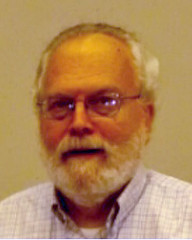 "The Maryland Token and Medal Society (MD TAMS) has lost its long-time president and guiding light, Edward Craig. Ed was a 35 year member of our organization and president for over 25 years. Much of the success of MD TAMS during this time period was due to Ed. He presided over meetings and swap-meets, wrote articles, and aided in the publishing of MD TAMS reference books.
"The Maryland Token and Medal Society (MD TAMS) has lost its long-time president and guiding light, Edward Craig. Ed was a 35 year member of our organization and president for over 25 years. Much of the success of MD TAMS during this time period was due to Ed. He presided over meetings and swap-meets, wrote articles, and aided in the publishing of MD TAMS reference books.
"A member of several collecting organizations, Ed was a past-president of the Maryland State Numismatic Association (MSNA) and for many years could be seen helping behind the desk of the Whitman Coin Expos held in Baltimore. He was a member of the national Token and Medal Society (TAMS) and the National Token Collectors Association (NTCA) as well. While Ed's primary collecting interest was Maryland tokens and medals, he also was a well known collector of Alaska and Hawaii exonumia. For many years Ed traveled to Hawaii to visit friends and fellow collectors.
"In a time of declining membership Ed was the glue that helped keep our club together; his loss is enormous. He was a good friend who will be missed not only by MD TAMS, but by many in the collecting community."
JOHN EDWARD GUSMANO (1963-2024)
An article in the January-March 2024 issue of TEC News from The Elongated Collectors Inc. profiles elongated coin engraver John Gusmano, who died last month. With permission, we're republishing it here. Sorry to hear this news. -Editor
 Prolific elongated coin engraver John Gusmano, TEC #4513, died March 6, 2024, in Grand
Rapids, Michigan, “peacefully and with a heart full of love,” according to his family, following
an eight-month-long battle with lung cancer. He was 60.
Prolific elongated coin engraver John Gusmano, TEC #4513, died March 6, 2024, in Grand
Rapids, Michigan, “peacefully and with a heart full of love,” according to his family, following
an eight-month-long battle with lung cancer. He was 60.
“The world of elongateds has lost a true talent,” said TEC president, Tyler Tyson, TEC #3262. “Those that worked with John understand the loss.”
Among those is Michelle Kilcoyne, TEC #5096, graphic designer, engraver, owner of The Penny Depot, and daughter-in-law of James and Carol Kilcoyne, TEC #1887 and #3176. “John’s absence will be deeply felt; he leaves an indelible mark on the elongated penny world,” she said.
NNP ADDS TO CONGRESSIONAL REPORT SERIES
The latest additions to the Newman Numismatic Portal are Congressional Reports with numismatic content. Project Coordinator Len Augsburger provided the following report. -Editor
Newman Portal Adds to Congressional Report Series
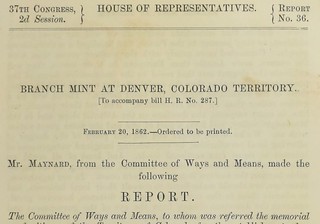 Courtesy of Paul Hybert, we have added to Newman Portal a large group of U.S. congressional reports with numismatic content. This series now includes 375 items, and we acknowledge also Dan Hamelberg, who has previously contributed to this group. As Congress exercises its authority over the nation’s coinage, this series documents an important part of our numismatic history. Congress authorizes new coins, personal medals, and controls other aspects of coinage, such as the restoration of Mint marks in 1967.
Courtesy of Paul Hybert, we have added to Newman Portal a large group of U.S. congressional reports with numismatic content. This series now includes 375 items, and we acknowledge also Dan Hamelberg, who has previously contributed to this group. As Congress exercises its authority over the nation’s coinage, this series documents an important part of our numismatic history. Congress authorizes new coins, personal medals, and controls other aspects of coinage, such as the restoration of Mint marks in 1967.
From a bibliophilic perspective, these reports typically come disbound. The Congressional serial set, which documents activities of the House and Senate, is a massive record, on the order 20,000 printed volumes. As institutions deaccession these volumes over time, numismatic sections are extracted and occasionally trade in the numismatic literature marketplace. With electronic access to the Congressional serial set now available via ProQuest subscription, institutions have less of a need to maintain hardcopy sets, not to mention the cost of maintaining a facility to house the material.
VIDEO: COINAGE OF THE ENGLISH CIVIL WAR
The David Lisot Video Library on the Newman Numismatic Portal can be found at:
https://nnp.wustl.edu/library/multimediadetail/522852
We highlight one of his videos each week in The E-Sylum. Here's one from 2005 with Arthur M. Fitts speaking about the coinage of Charles I and the English Civil War. -Editor
NOTES FROM E-SYLUM READERS: APRIL 14, 2024
More on Maundy Money Terms
David Pickup writes:
"Are recipients of Maundy money “maundees”?!"
Ken Berger writes:
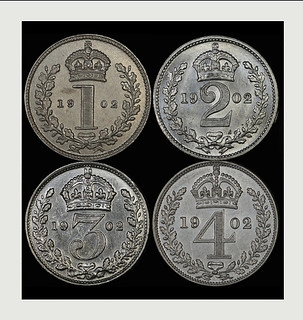 "With respect to Michael T. Shutterly's comments regarding the derivation of the word Maundy, I believe that some clarification is needed. He refers to Vulgate Latin as if it is different from regular Latin. Except for one very minor structural difference, Vulgate Latin refers basically to how it was pronounced compared to Classical Latin. (For example, the word Caesar would be pronounced as Kaiser in Classical Latin & Chaysar in Vulgate Latin.)
"With respect to Michael T. Shutterly's comments regarding the derivation of the word Maundy, I believe that some clarification is needed. He refers to Vulgate Latin as if it is different from regular Latin. Except for one very minor structural difference, Vulgate Latin refers basically to how it was pronounced compared to Classical Latin. (For example, the word Caesar would be pronounced as Kaiser in Classical Latin & Chaysar in Vulgate Latin.)
"Vulgate Latin was the Latin spoken by the common masses of people, whereas Classical Latin was spoken by the upper classes. For obvious reasons, the Latin used by the Catholic Church was Vulgate Latin. Shutterly's example of novum mandatum is written in Latin, not Vulgate Latin nor Classical Latin, just Latin.
"P.S. This difference in pronunciation caused me some problems in my high school Latin 3 class. I had been taught Classical pronunciation whereas my teacher was using Vulgate pronunciation. Since my pronunciation was technically not wrong, my teacher had to accept it."
Thanks, everyone. -Editor
To read the earlier E-Sylum articles, see:
MAUNDY COINAGE THEN AND NOW
(https://www.coinbooks.org/v27/esylum_v27n13a24.html)
NOTES FROM E-SYLUM READERS: APRIL 7, 2024 : Vocabulary: Maundy
(https://www.coinbooks.org/v27/esylum_v27n14a10.html)
NOTES FROM E-SYLUM READERS: APRIL 7, 2024 : Vocabulary: Giftees and Uncirculated Medals
(https://www.coinbooks.org/v27/esylum_v27n14a10.html)
Other topics this week include Bernard Rome and starting Teletrade. -Editor
VOCABULARY TERM: PIERCING
Here's another entry from Dick Johnson's Encyclopedia of Coin and Medal Terminology. -Editor
Piercing. The process of perforating, punching or cutting out open areas in fully struck metal items as part of their intended design; openwork. Piercing is the most severe design element a coin or medal designer can employ in creating a design, it removes the opportunity for any design, texture, patina finish – anything! – in that area for both sides.
By creating "vacant space" or "negative mass" the designer consciously permits showthrough of any surface held behind the item; it also gives the greatest possible emphasis to the edge that has been outlined. Thus the outline shape of a pierced item often becomes more important than the design shown on either side. Such openwork adds exclusiveness to certain medallic designs, as with decorations of honor or orders, most of which have openwork and those of highest rank have the greatest amount of piercing and for the greatest visual distinction for pierced coins. Piercing is a technique for struck medals only, as cast medals have openwork created by the casting form.
COPE COLLECTION OF BRITISH COINS OFFERED
In a joint sale in Zurich May 8, 2024, three firms are joining forces to offer the Cope Collection of Roman and British coinage. Here's the press release. -Editor
A spectacular Roman bronze coin depicting Emperor Hadrian addressing the legions of Britannia, and a magnificent silver “Petition Crown” of King Charles II, are among the many highlights of the Cope Collection coming to the auction block on May 8 in Zurich, Switzerland under the auspices of three firms – Numismatica Ars Classica AG, Classical Numismatic Group LLC, and Numismatica Genevensis SA.
Assembled over 50 years by the clothes retailer and numismatist Geoffrey Cope of Leeds, UK, the Cope Collection comprises 170 ancient Roman bronze coins and more than 800 British issues. Condition was paramount: a significant number of the coins are considered the finest of their type. A second auction session featuring the rest of Cope’s British holdings will take place in October 2024.
GRANT REUNION BOOK AND MEDAL
Here's an offering for both numismatists and bibliophiles - a book containing a medal for the 1893 Ulysses S. Grant Reunion Dinner. I don't believe I've encountered this item before. -Editor
RARE 1893 Ulysses S Grant Reunion Inner Book with Important Struck Medal Republican Convention EX Libris William J Latta Penn Railroad President
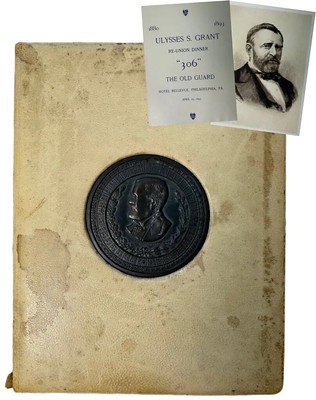 Commemorative book of the June 1880 Chicago Republican National Convention in which former Union General and then-sitting U.S. President Ulysses S. Grant was seeking an unprecedented 3rd consecutive term. Of the 14 men in contention for the Republican Nomination, the three strongest leading up to the convention were Grant, James G. Blaine, and John Sherman. After 35 ballots, there was still no decisive nominee; this is when Blain and Sherman switched their backing to a “dark horse” candidate in James Garfield. On the next ballot Garfield won the nomination with 399 votes, 93 more than the incumbent Grant. Garfield was declared the nominee the same day, and ultimately won the Presidency- a position he would hold for just over 6 months until his assassination at the hands of Charles J. Guiteau.
Commemorative book of the June 1880 Chicago Republican National Convention in which former Union General and then-sitting U.S. President Ulysses S. Grant was seeking an unprecedented 3rd consecutive term. Of the 14 men in contention for the Republican Nomination, the three strongest leading up to the convention were Grant, James G. Blaine, and John Sherman. After 35 ballots, there was still no decisive nominee; this is when Blain and Sherman switched their backing to a “dark horse” candidate in James Garfield. On the next ballot Garfield won the nomination with 399 votes, 93 more than the incumbent Grant. Garfield was declared the nominee the same day, and ultimately won the Presidency- a position he would hold for just over 6 months until his assassination at the hands of Charles J. Guiteau.
The event occurred only 16 years after the assassination of Abraham Lincoln, and was a catalyst for the formation of the Secret Service. This book is a re-union commemoration and delineates the selection process of Grant. Given by a Mr. Isaac M. Loughead to William J Latta, the Penn Railroad President, on July 7, 1893. Adorned on front and back with bronze medals, the first bearing a struck-bust of Grant, and the second inscribed “Commemorative of the 36 Ballots of The Old Guard for Ulysses S. Grant for President. Republican National Convention Chicago June 1880.”
THURSDAY LUNCH CLUB REPORT APRIL, 2024
Ray Williams of New Jersey submitted this report of the recent meeting of his Thursday lunch club. Thanks! -Editor
We were missing three friends today, Matt Virga, Wayne Shelby and Dan Knight. Meeting on a semi-regular basis, we should consider obtaining an official name for our lunches...a club name of some sort. You guys in Virginia have Nummis Nova. At lunch we share personal stories, numismatic items, personal research and numismatic comings and goings (along with aches and pains and medical issues - LOL). Typically we enjoy about two hours of fellowship. The lunch club members all have a common interest in colonial numismatics - coins, medals and paper.
COINS OF JUSTINIAN THE GREAT
Mike Markowitz published a CoinWeek article on the coins of Justinian the Great. Here's an excerpt - see the complete article online. -Editor
Born to a peasant family in what is now North Macedonia about the year 482 CE, Justinian earned his epithet “the Great” as a conqueror, a builder, an administrator, and, according to some contemporaries, a monster. The coinage of his long reign (527-565 CE) illustrates his extraordinary career.
ON COLLECTING BYZANTINE COINS
In his The Rational Optimist blog, Frank Robinson wrote about building a collection of Byzantine coins. Here's an excerpt - see the complete article online. -Editor
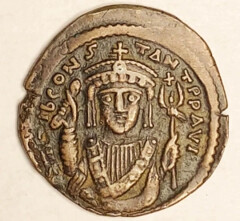 In my coin dealing business, customers like to sell me stuff. Couple years ago a guy drove up with a rented U-Haul fully packed with coins he said he’d been collecting since 1949.
In my coin dealing business, customers like to sell me stuff. Couple years ago a guy drove up with a rented U-Haul fully packed with coins he said he’d been collecting since 1949.
More recently another longtime customer sold me his ancient Greek coins. Turned out he’d specialized in the tiniest ones (like 3 to 8 millimeters). I gave him a price he was happy with. Had to work up a new technique to photograph such micro coins for my auctions.
Then he asked if I’d be interested in his Byzantine coins. Love them, said I.
BYZANTINE SILVER BECAME MEDIEVAL COINS
University researchers have determined that melted-down Byzantine treasure provided the source of much of the silver coinage fueling Britain's medieval economic boom. Here's an excerpt from a University of Cambridge article. The original paper is linked here as well, along with a Smithsonian article forwarded by Larry Korchnak. Thanks. -Editor
Byzantine bullion fueled Europe's revolutionary adoption of silver coins in the mid-7th century, only to be overtaken by silver from a mine in Charlemagne's Francia a century later, new tests reveal. The findings could transform our understanding of Europe's economic and political development.
Between 660 and 750 AD, Anglo-Saxon England witnessed a profound revival in trade involving a dramatic surge in the use of silver coins, breaking from a reliance on gold. Around 7,000 of these silver 'pennies' have been recorded, a huge number, about as many as we have for the rest of the entire Anglo-Saxon period (5th century–1066).
MALAYSIAN SHIPWRECK COIN FIND
A 500-year-old shipwreck found in Malaysia yielded a hoard of coins. Here's an excerpt from a Miami Herald article. -Editor
In 2020, researchers stumbled upon something unusual on an island off the coast of Malaysia: a collection of rectangular pieces of wood sticking up from the ground.
Intrigued, scientists decided to excavate the site, revealing the remains of a centuries-old shipwreck filled with a trove of coins and ceramics, according to a preprint study posted to Research Square, an open access platform, on April 2.
Though it was found on an island, the landscape at the time of the ship’s sinking was undoubtedly different, researchers, who are affiliated with various Malaysian institutions, said.
CANADA’S FIRST AMERICAN VICTORIA CROSS
In the did-you-know department, an American earned a Canadian Victoria Cross in WWI. -Editor
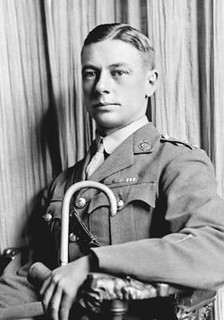 ‘I’m fed up to the teeth,’ said Sergeant George Harry Mullin as he handed out rum rations to his Canadian comrades on Oct. 29, 1917. ‘Tomorrow morning it’s either a wooden cross or a VC for me.’
He would soon be proven right on one of those counts.
‘I’m fed up to the teeth,’ said Sergeant George Harry Mullin as he handed out rum rations to his Canadian comrades on Oct. 29, 1917. ‘Tomorrow morning it’s either a wooden cross or a VC for me.’
He would soon be proven right on one of those counts.
Mere hours later, amid the Battle of Passchendaele, Mullin’s “gallantry and fearlessness,” as his Victoria Cross citation reads, earned him a place among a select few awarded the British Empire’s highest military accolade.
Rarer still was his unique position within the esteemed and courageous group: an American-born recipient.
U.S. MINT OATH OF ALLEGIANCE MEDALS
Stack's Bowers Numismatist Chris Bulfinch published an article on the U.S. Mint Oath of Allegiance medals. -Editor
After the seizure of the Southern branch mints by the Confederacy at the outset of the Civil War, the loyalty of Mint employees was taken seriously at the facilities remaining under federal control. Employees took an oath of allegiance to the Union and medals were struck commemorating it.
Anthony Paquet, then assistant engraver at the Mint, adapted a portrait used for the Washington Medal Cabinet Collection medal and prepared a simple reverse with text explaining that “U.S. Mint OATH OF ALLEGIANCE TAKEN BY THE OFFICERS AND WORKMEN, SEPT. 2, 1861” encircled by a laurel wreath.
Cataloged as Baker-279, (R.7), Julian-CM2, and Musante GW-476, the medals were produced through the 19th century and into the 20th in three metallic compositions, according to Mint delivery records.
ROSIE THE RIVETERS CONGRESSIONAL GOLD MEDAL
The latest Congressional Gold Medal went to Rosie the Riveters. Here's an excerpt from a New York Times report of the award ceremony, along with U.S. Mint images of the medal. Go ladies!! -Editor
Soon after the attack on Pearl Harbor in 1941, Marian Sousa moved to California to care for the children of her sister Phyllis Gould, who had gone to work as a welder in a Bay Area shipyard.
Just a year later, Ms. Sousa, at 17 years old, joined the wartime work force herself, drafting blueprints and revising outdated designs for troop transports. Wearing a hard hat and with a clipboard in hand, she would accompany maritime inspectors on board ships she’d helped design and examine the product of her labors.
She and her sister were just two of the roughly 6 million women who went to work during World War II, memorialized by the now iconic recruitment poster depicting Rosie the Riveter, her hair tied back in a kerchief, rolling up the sleeve of her denim shirt and flexing a muscle beneath the slogan, “We can do it!”
PAPER MONEY OF FREDERICKSBURG, VA
An article by Neil Hening on the paper money of Fredericksburg, VA appeared in the Winter 2024 issue of The Virginia Numismatist from the Virginia Numismatic Association. With permission, here's an excerpt. Thanks! -Editor
Fredericksburg’s first bank began when the state-chartered, Bank of Virginia in Richmond opened a branch in Fredericksburg in 1804. The charter authorized Fredericksburg as one of the first towns to have a branch. Many businessmen complained about the monopoly of the Bank of Virginia, and the state chartered the Farmers Bank of Virginia in 1812, with a branch in Fredericksburg. We are fortunate that two ‘minute books’ for the Farmers Bank of Virginia survive for the main bank in Richmond. They are dated 1820 - 1827 and 1841 - 1853 respectively. Various branches of the bank are cited in these minutes. Germain to Fredericksburg, the minutes record that worn out and unusable banknotes were returned to Richmond for replacement and destruction. In 1824, the minutes reflect the destruction of $129,000 face value of banknotes ranging from $5 to $100 denominations, amounting to 3,236 banknotes. Two additional financial institutions opened in Fredericksburg and issued banknotes before failing.
LOOSE CHANGE: APRIL 14, 2024
Here are some additional items in the media this week that may be of interest. -Editor
Collectors, parent of Professional Coin Grading Service (PCGS) and owned by hedge fund manager Steve Cohen has inked a new deal with eBay. -Editor
As eBay continues to invest in the trading card space, the e-commerce company announced Wednesday three significant commercial transactions with Collectors, the parent company of PSA (Professional Sports Authenticator), the third-party authentication and grading provider in the collectibles industry.
The transactions include a trading card commercial agreement that aims to provide trading enthusiasts a seamless buying, selling, grading and storage experience. As part of the partnership, eBay and PSA plan to introduce a “customer-centric product experience” over the coming months. Plus, PSA is launching a new service for customers to list trading cards on eBay as soon as the card is graded in order to accelerate the selling process.
Additionally, eBay acquired Collectors’ auction house Goldin, a significant move that will greatly benefit collectors. The sale helps eBay expand the range of inventory for buyers as well as give Goldin sellers a wider audience.
eBay is also selling the eBay vault to Collectors, creating a new offering that merges the existing vault services. Launched in 2022, the eBay vault allows collectors to store trading cards that are valued at more than $750 in a secure, temperature-controlled vault.
To read the complete article, see:
eBay enters trading card commercial agreement with Collectors, acquires Goldin
(https://techcrunch.com/2024/04/10/ebay-enters-trading-card-commercial-agreement-with-collectors-acquires-goldin/)
Other topics this week include State Quarters, and Nigerian Banknote Abuse. -Editor
DU SIMITIERE SKETCH DISCOVERED
Michael Oppenheim forwarded this Washington Post article about the discovery of a rare Revolutionary War drawing by an important colonial figure with a numismatic connection - Pierre Eugene Du Simitiere was an early collector and founding father of American numismatics that Joel Orosz wrote about in his 1988 book, The Eagle that is Forgotten. -Editor
After waiting for two years, Matthew Skic was excited to visit the New York City apartment of a collector of early American art. The curator of exhibitions at the Museum of the American Revolution in Philadelphia had heard reports about Judith Hernstadt’s impressive array of artifacts from the colonial period, which she had gathered over the past 40 years.
Because of the covid pandemic and other commitments, Skic had to delay his tour until August 2023. His patience was rewarded when he witnessed Hernstadt’s assemblage of prints, paintings, furniture and other rare items from the late 18th century.
FEATURED WEBSITE: WHITMAN BRANDS
This week's Featured Website is the new Whitman Brands home.
CDN Publishing and Whitman Publishing have united, creating a historic moment in numismatic history.
Whitman’s legendary brands, such as the revered Red Book, Blue Book, and an expansive line of folders, albums, and supplies, have long dominated the retail landscape. Meanwhile, CDN Publishing boasts esteemed wholesale brands like Greysheet, Greensheet, CPG, CDN Exchange, and the Banknote Book.
Whitman Brands marries CDN’s data-driven wholesale expertise with Whitman’s retail prowess, offering a comprehensive and intellectually rich coverage of collectibles. Embrace the heritage, explore the vast array of publications, and become part of a movement that celebrates the richness of numismatics.


